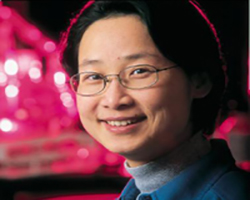
For a scientist, having one’s research published in a peer-reviewed journal signifies a high level of professional expertise and accomplishment. If that journal happens to be Science or Nature—two of the world’s top scientific publications—so much the better.
One Florida State University researcher has achieved a unique level of distinction: co-authoring papers for both journals—and within a week of each other.
Hong Li, an assistant professor of chemistry and biochemistry in FSU’s Institute of Molecular Biophysics, co-authored a paper with FSU postdoctoral researcher Song Xue and molecular biophysics graduate student Kate Calvin that appeared in Science on May 12. itled "RNA Recognition and Cleavage by a Splicing Endonuclease," the paper offers new insights into the structures of "biomolecules," organic molecules such as proteins and nucleic acids that exist in living organisms.
"My group applies a physical technique called X-ray crystallography to view biomolecules in three dimensions at atomic scales," Li said. "Knowing the shape and associated chemical properties of biomolecules provides the foundation for understanding how they work to sustain the life of cells."
This is analogous, although at quite different scales, to dissecting the human heart in order to understand how it works and its role in blood circulation. It is still quite challenging to obtain structures of novel biomolecules, and it is even more challenging to capture the structure of "molecules in action."
The second paper, "Cleavage of Pre-tRNAs by the Splicing Endonuclease Requires a Composite Active Site," was published in the May 18 issue of Nature. Li co-authored that paper with scientists from PTC Therapeutics, a biopharmaceutical company based in South Plainfield, N.J. Like the Science article, it discusses findings involving biomolecular structures known as "introns," which are intervening sequences found in human genes that separate the stretches of DNA that code for functional molecules such as proteins and RNA. Introns are "similar to commercials that interrupt our favorite programs," as Li describes them.
"These studies enable us to learn the underlying chemical and physical principles for how molecules in cells recognize and interact with one another and how chemical reactions occur," she said.
"Professor Li’s work is yielding important information on the functioning of biomolecules and could lead to new treatments for a variety of health problems," said Professor Timothy Logan, the interim director of the Institute of Molecular Biophysics. "Many scientists work for their entire career without publishing in these prestigious journals. To have two papers published within a week’s time by two of the world’s top science journals is a remarkable achievement. It is the research of such caliber and excellence in teaching that led to Dr. Li’s recent promotion to associate professor with tenure at Florida State University."
Science (www.sciencemag.org), published by the American Association for the Advancement of Science, is the world’s leading journal of original scientific research, global news and commentary. Nature (www.nature.com), the world’s foremost weekly scientific journal, was launched in 1869.
FSU’s Institute of Molecular Biophysics (www.sb.fsu.edu) is an interdisciplinary research unit dedicated to the application of physical and chemical principles to the investigation of biological phenomena. The seeds of the institute were sown in 1959 by a group of chemists, biologists, physicists, psychologists and other FSU scientists who foresaw the need for close-knit cooperation among traditional disciplines in the rapidly evolving research area of molecular biology. Today, the Institute of Molecular Biophysics focuses on computational biophysics and structural biology, creating an environment that fosters interdisciplinary research and training for graduate students in biology, biochemistry, molecular biophysics, mathematics and physics.




